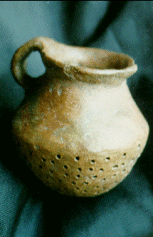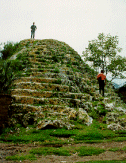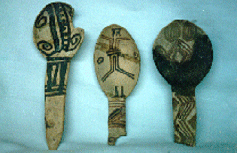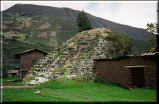« Arqueología »
Marcamachay
They are up to now númerosas the evidences ignored by the exploration lack and study.
It recognized this way it for that time the archaeologist Dr. Theodore Mc Cown, and in this respect he/she manifested: "It is the town of Marcamachay, this district that repeated times describó, has abundant remains and on the hill Wakra and Yanaorco in the suburbs to the north of the town of Sitacocha, for what I had the desire to investigate this region. "
In their book Pre-Incaic-Huamachuco Survey and excavations in the Region of Huamachuco and Cajabamba", published in 1942, it is captured that the necessity existed of making bigger studies to the interior of Cajabamba and power to understand better than it is what Inca Pre happened with the societies.


Archaeologist Mc Cown's presumption, on the area was due to the references and the listened manifestations of the old proprietors of the former country properties: Marcamachay, Jocos, Sitacocha, Wakra, Corduroy, Cujibamba, Chuquitén, Yanás and diverse places on the Marañón, where the peasant was shown of the big accumulations and concentrations of archaeological remains, strengths, platforms, aqueducts, necropolis and osarios.
Some of those mentioned evidences in Llautorco of inaccessible places, neither escaped to the hopeless fury of the looting and the preservation lack; the peasant destroyed, in his desire of snooping, the time was also and it continues destroying, being every distant time the reach for the scientific and interpretive study of that happened in these diverse places.
It is very common to observe that in the highest summits, the man has left prints of having modified these elevationswhose summits maintain remains of their walls, pircas.
In 1939 it passed in Mission of Study the Dr. Julio C. Tello with address to Chilia (County of Pataz), contacting the Maximum professor Barrueto who years later it would occupy the position Ad-Honoren of Inspector of Archaeological Monuments of Cajabamba. It provided 21 skulls, which it maintained in the school like part of the collection of a school museum.

Later on, the Dr. Theodore McCown had Mr. Barrueto, for recommendation of Tello, like one of the best guides driving him to: " Laymina ", Ayangay, Otuto, Pampas of the Quinuales, Cave of the León, Cerro Callanas, Gulch of Ayanday and the Black Rock, of there that their journey is only based on the surroundings of Cajabamba.
The events of the Second World War, he/she forced him to be brief to McCown in their study and to return to their native country.
But their contribution is momentous in the Peruvian Archaeology leaving studies like the place that it visited in the sepulchers of Ayangay, in which could be observed funeral tapas covered with carved stone flagstones from 4 to 6 meters, superimposed.
Of the School Museum of that time that accumulated archaeological goods, the existence referencial is known that some of the diverse accumulated skulls, some presented deformation dolicocéfala occipital, brachycephalic fronto and others with persistence of the half front suture or metópica.

The works carried out by architect José Pineda Quevedo, in their book Patterns of Establishment Hispanic Pre of the Valley of the Condebamba 1989. He helps us to visualize the diverse social processes and their level reached in the evolutionary development generically, in the same way, the cultural filiations that prevailed in the valley of the Condebamba.
The studies of Pineda manifest a clearing and notable change in the population of this area, which began to occupy towns in the high parts of the hills, on the 3,00 m.m.s.n.m., that that previously didn't happen for the valley of the Condebamba, these towns depended on Marcahuamachuco in that time.
In most of the high parts, occupied by the man Hispanic pre, the same as other parts of the Peru; in the one that was difficult to destroy the big ones salient natural; they opted to take advantage with ability these homes, in such a way that you/they were making embankments.
The level curves only indicate us with clarity of these varied terraces that go staggering in form to circulate and notorious summit, today covered by vegetation, under these small mounts, when ascending, he/she leaves assimilating that this, every time, he goes being enlarged in the parts that lower being adjusted to the natural means of the rocky structure and that it didn't only complete highly a function defensive and of subsistence, but rather also, in them there are rectangular, such remains of patios it is the case of " Llautorco "; these lands enlarged artificially in their surface harbor fragments of ceramic of diverse stages.
The man's prints in these homes converge from a place to another with the local manifestation: it can be observed places with an accented one it influences wari. Cajabamba has a marked influence Cajamarquina and the relationship with identified Huamachuco for the late Intermediate period (700-800) D.C. being this the one that covered the whole area, also having peculiarity of diverse influences that were present, without being obviated the coastal influence and the cultures of the Marañón due to the intense exchange.

Inside the Quechua toponimia we have some terms that got our attention, as the denominated place " Marcamachay " in which their components derive of the words " Mark " that it means region, village, town and high part. The term " Machay ", according to Flores Galindo, identified in other you leave of Peru like old cemeteries, caves, grottos, caverns", according to the archaeological investigations it is reaffirmed to this terms, these caverns that served as room, were also denominated to some adoratorios or sepulchres. " Machay " was sacred place
Such it is this way that in the colony the habit even persisted of transferring to the deads from the Catholic temple to the " Machay " it was an act that consecrated the reencuentro of the Andean men with another tradicción. It remitted them to their own lineages and through them to the world of their divinities. Inside the district of Sitacocha, " Marcamachay " is located and among the town he/she is a singular rocky promontory, the one was worked in its part he/she is having an excellent one rectangular in the high part, everything makes indicate that there they were carried out certain rituals with orientation to the concealment in the sun.

It is extremely lamentable that several of these distant places they have been plundered, because the loss of the information arqueólogica is irreparable, such it is so to see the disturbed stone pieces of what was a mortuary enclosure, they are common, because him little that they inform us it is that, these they had been construídos in forgotten form or hit to the rock, in the such geologic flaws it is so in some of these places they appear remains of spread human skeletons.
The structures were elaborated with plane stones together with mud, era observable certain white stone that for reference of the lugareñossabemos that put it to the fire for later on " Chacchar " the coca, stone of origin calcario is it is escaza for these places.
Some of the small structures falls are not neither the reduced entrance in some in other is aperciable the lintel of sticks that it sustained it. The enclosure funerarío the same as other places of the Peru and américa fué, apparently, a practice generalized in some towns inside their autochthonous development

In 1950 Reichlen it proves the existence of these in the valley of the Utcubamba, Amazons, seven years later Horkheimer details some for Junín in the area of Pachayo.
In 1959 Mirror, it reports for Cajamarca in the beach of the Coconut tambíen Matos 1960. Estrada in 1981 describes for some with this similarity for Huancavelica.
lthough it is certain that they are diverse the places with these peculiarities; these they differ the some of the other ones in their architectural elements.
Those of Yanas are of simple architecture, they don't present niches neither plastered, neither paintings, although they only respond to the same functional modality of being you embroidered funeral.
 To return
To return